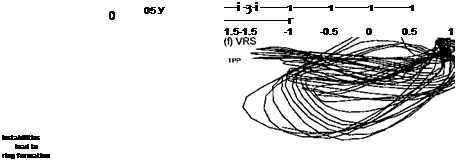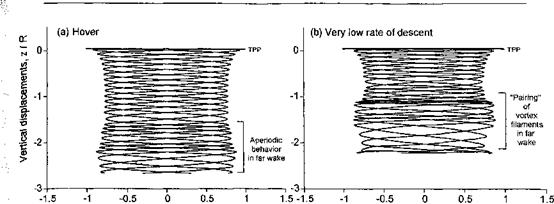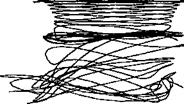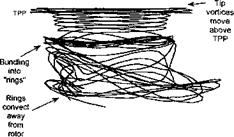Descending Flight and the Vortex Ring State
|
The problem of the vortex ring state (VRS) has already been discussed in Sections 2.13.6 and 5.7. VRS is a problem. that is not amenable to solution (prediction) by methods such as momentum theory, and more advanced prediction methods must be sought. Developments of free-vortex and vorticity transport models (see Section 14.3) have recently allowed the problem of VRS to be examined in much more detail, and for the effects of flight condition and rotor geometry on the VRS problem to be better exposed – see Brown et al. (2002) and Newman et al. (2004). However, a primary difficulty in either approach is to faithfully model the tip vortices in the rotor wake to old ages, as well as the problem of modeling accurately the physics of vortex-vortex and blade-vortex interactions. Another difficulty is that the descending flight problem is inherently unsteady, so time-accurate methods of solution such as discussed in the previous section are a necessary prerequisite. To illustrate the general behavior of the wake in descending flight, Fig. 10.49 shows views of a rotor wake that have been predicted using a FVM for a notional four-bladed rotor when transitioning from hover into axial descent. Six free-vortex turns were used to model the rotor wake; a fairly large number of wake turns must be used because the older vortex filaments can come close to the rotor disk plane as VRS is approached and accurate modeling is important here. All results show a “snapshot” of the wake at an arbitrary instant in time. In hovering flight Fig. 10.49 shows that the wake consist of sets of nearly helical, closely interdigitated vortices, but with some evidence of wake disturbances and an aperiodic behavior in the far wake, as discussed previously in Section 10.5.1. See also Leishman et al. (2002a). For very low rates of descent there is more evidence of a wake instability and the subsequent formation of vortex perturbations. Because of the imposed descent velocity, the wake cannot be convected as far downstream below the rotor in a given time and the downstream wake filaments begin to “bundle” together. If the rate of descent is low enough then the developing bundles of vorticity are still confined to the far wake well downstream of the rotor and are convected away from the rotor as fast as they develop. For these low rates of descent the bulk of the wake is still in equilibrium and there is little or no effect on the blade airloads or rotor performance. As the rate of descent is increased further, however, the net velocity through the rotor disk is decreased and more of the vorticity generated at the blade tips begins to accumulate near the rotor TPP. At some point, the descent velocity is high enough to cause the tip vortices to convect into the TPP after they are first formed, thereby creating a form of BVI. Notice that the developing perturbations in the wake also become more evident, and because of the higher rotor descent velocity in this case these perturbations now lie much closer to the rotor. While the wake cannot yet be considered to have “broken down” for these descending flight conditions, a characteristic feature is that parts of adjacent vortices pair together and eventually tightly clump or bundle, essentially forming toroids or vortex rings. These vortex rings themselves are not stable and naturally begin to develop a series of Kelvin waves |
|
I |
|
-3- |
|
1 i |
|
t r t f |
|
|||
|
|||
|
|||
|
|||
|
|
||
 |
|||
|
|||




![]()
3 ![]() | ■ і і і | | -3 і і і———– 1———— 1———– 1
| ■ і і і | | -3 і і і———– 1———— 1———– 1
-1.5 -1 -0.5 0 0.5 1 1.5 -1.5 -1 -0.5 0 0.5 1 1.5
Lateral displacements, y/R Lateral displacements, у / R
Figure 10.49 Effects of rate of descent on rotor wake developments predicted using free – vortex theory. The rotor has a solidity of 0.1, with —13° of blade twist per radius, and was operated at Cj = 0.008 with a tip Mach number of 0.65.
[see also Fig. 10.15(a)]. These waves tend to grow in amplitude and begin to affect the flow field near the rotor and so influence the rotor airloads. Nevertheless, at these relatively low rates of descent the net velocity is still mostly downward through the rotor and the vorticity associated with the wake perturbations is convected away from the rotor disk.
Figure 10.49(e) shows that the rate of descent can eventually be increased to the point that the accumulated vorticity and developing wake perturbations are within reach of the rotor TPP. Under these conditions, the aperiodic wake developments begin to affect the blade loads. There is again strong evidence of vorticity accumulation and “vortex ring” formation, but the rings convect slowly away from the rotor as they become unstable. This
condition, therefore, can be considered symptomatic of an incipient wake breakdown and a VRS onset condition. A slightly greater rate of descent then takes the rotor into the classic features of the VRS, which is usually (but imprecisely) defined on the basis of the rotor operating in the bulk of its own wake. Under these conditions the wake loses most of its well-defined structure. Of significance again is that vortex rings are formed. Because the net flow velocity at the rotor disk is now very low, these rings lie close to or pass through the TPP (compare also with Figs. 2.21 and 2.22) and the blades intersect large concentrated regions of accumulated vorticity. This leads to locally high unsteady blade airloads and large fluctuations in rotor thrust, which are known characteristics of VRS (Section 5.7). Notice that these vortex rings are also unstable and themselves exhibit evidence of Kelvin waves that quickly grow in amplitude, causing the rings twist over and forming a series of knots. Eventually the rings themselves break down and their associated vorticity is convected away from the rotor. Notice that because of the small axial (slipstream) velocity near the rotor at this rate of descent, most of the vorticity is convected radially (and not axially) away from the rotor disk. This process of vorticity accumulation and vortex ring formation is not necessarily periodic, but the basic process of ring formation, ring breakdown and convection of the accumulated vorticity away from the disk is repeated for as long as the rotor operates in the conditions that would promote it. See also Section 14.10.7 for further results on the VRS problem.











